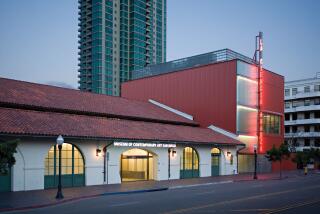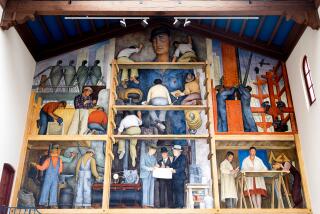Selling Detroit museum art to pay civic debt is dumb
- Share via
In a bizarre letter to the New York Times this week, retired museum director Frank Robinson mischaracterized the problem being faced by the Detroit Institute of Arts in the Michigan city’s ongoing bankruptcy drama.
Addressing what he called an “agonizing question,” Robinson asked: “How many lives is a Rembrandt worth?”
The struggle is framed as one between the stomach and the spirit. The survival needs of retired firefighters, nurses, police officers, teachers, civil servants and other strapped pensioners are real. So are city-owned works of art with a combined monetary value of billions of dollars. The letter links the two.
CRITICS’ PICKS: The best art in town
In short, Detroit is having a fire sale and some say the museum’s art collection should be part of an inventory close-out. The museum could sell paintings and sculptures to help pay civic debts, including at least $3.5 billion in unfunded pension liabilities.
That’s not merely an exercise in irrelevancy, it’s a cruel distraction. It accepts the false terms being advanced by one side in a long-term political fistfight, which has been underway in the United States since the 1980s.
The situation in Detroit is complex. But there’s a simple way to describe any plan to cope with the city’s crushing debts by auctioning off great paintings by Veronese, Rembrandt, Van Gogh and other artists from the stellar holdings amassed over the last century by the Detroit Institute of Arts.
The claim of such a plan goes like this: Privatize a great art collection owned by the public, and the benefits will trickle down to the people.
Yes, it’s our old friend – and I use the word sarcastically -- trickle-down theory, the one championed 30 years ago by the Reagan administration. George H.W. Bush, in a rare moment of candor uttered before he signed onto the No. 2 spot on the 1980 Republican presidential ticket, called it voodoo economics. We are reaping that supply-side whirlwind now.
Will we fall for it again in Detroit? Supplying art masterpieces to a booming luxury-goods market will supposedly mean ponies and party hats for pensioners. Fat chance.
PHOTOS: Arts and culture by The Times
During the 1890s -- America’s last Gilded Age, and the era when the Detroit Institute of Arts was established -- this was known as the horse-and-sparrow theory. If you feed a horse enough oats, some will pass through to the road for the sparrows.
The stinky vehicle for the pass-through should be enough of a clue: Supply-side economics didn’t work then, and it doesn’t work now.
Robinson, who retired from Cornell University’s Herbert F. Johnson Museum of Art in 2011, is not among those advocating sale of DIA art to fund threatened pensions. That error was made – and quickly reversed -- last month by New Yorker magazine art critic Peter Schjeldahl in a widely derided blog post. He was right to make a speedy U-turn.
But Robinson and Schjeldahl seem to be working from the same false premise, which says we can have public art museums or civic health but perhaps not both.
By contrast, Bloomberg architecture critic James S. Russell gets it. His recent column on the cultural angle of Detroit’s civic dilemma is the best I’ve seen.
Russell lambasted the foolishness of “a quick fix for a bankrupt city,” which is exactly what resides at the heart of an “asset-stripping orgy” like the potential sale of museum art. Detroit bankruptcy manager Kevyn Orr says there is no such plan, but we won’t really know until Christie’s auction house completes a requested DIA appraisal, expected by October.
Fixing a city’s broken infrastructure is no mean feat. That goes for the water department, the tax structure, the art museum, the pension system and more. But Russell is spot-on when he writes, “Detroit’s assets need to be understood in terms of what they can do to revive the city, not on what cash they will produce at auction.”
That’s how the Detroit Institute of Arts -- public repository of one of the nation’s greatest art collections -- needs to be considered now.
ALSO:
Sale of Detroit Institute art debated in light of city’s bankruptcy
Detroit debates if museum’s art can be sold to pay off city debts
New York museum returns to good graces after ban for selling art to pay bills
More to Read
The biggest entertainment stories
Get our big stories about Hollywood, film, television, music, arts, culture and more right in your inbox as soon as they publish.
You may occasionally receive promotional content from the Los Angeles Times.










